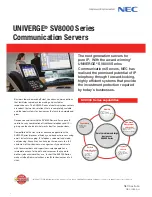
auto-volume
transfer/auto-disk
transfer
(AVT/ADT).
A
function
that
provides
automatic
failover
in
case
of
controller
failure
on
a
storage
subsystem.
AVT/ADT.
See
auto-volume
transfer/auto-disk
transfer
.
AWT.
See
Abstract
Windowing
Toolkit
.
basic
input/output
system
(BIOS).
The
personal
computer
code
that
controls
basic
hardware
operations,
such
as
interactions
with
diskette
drives,
hard
disk
drives,
and
the
keyboard.
BIOS.
See
basic
input/output
system
.
BOOTP.
See
bootstrap
protocol
.
bootstrap
protocol
(BOOTP).
In
Transmission
Control
Protocol/Internet
Protocol
(TCP/IP)
networking,
an
alternative
protocol
by
which
a
diskless
machine
can
obtain
its
Internet
Protocol
(IP)
address
and
such
configuration
information
as
IP
addresses
of
various
servers
from
a
BOOTP
server.
bridge.
A
storage
area
network
(SAN)
device
that
provides
physical
and
transport
conversion,
such
as
fibre
channel
to
small
computer
system
interface
(SCSI)
bridge.
bridge
group.
A
bridge
and
the
collection
of
devices
connected
to
it.
broadcast.
The
simultaneous
transmission
of
data
to
more
than
one
destination.
cathode
ray
tube
(CRT).
A
display
device
in
which
controlled
electron
beams
are
used
to
display
alphanumeric
or
graphical
data
on
an
electroluminescent
screen.
client.
A
computer
system
or
process
that
requests
a
service
of
another
computer
system
or
process
that
is
typically
referred
to
as
a
server.
Multiple
clients
can
share
access
to
a
common
server.
command.
A
statement
used
to
initiate
an
action
or
start
a
service.
A
command
consists
of
the
command
name
abbreviation,
and
its
parameters
and
flags
if
applicable.
A
command
can
be
issued
by
typing
it
on
a
command
line
or
selecting
it
from
a
menu.
community
string.
The
name
of
a
community
contained
in
each
Simple
Network
Management
Protocol
(SNMP)
message.
concurrent
download.
A
method
of
downloading
and
installing
firmware
that
does
not
require
the
user
to
stop
I/O
to
the
controllers
during
the
process.
CRC.
See
cyclic
redundancy
check
.
CRT.
See
cathode
ray
tube
.
CRU.
See
customer
replaceable
unit
.
customer
replaceable
unit
(CRU).
An
assembly
or
part
that
a
customer
can
replace
in
its
entirety
when
any
of
its
components
fail.
Contrast
with
field
replaceable
unit
(FRU)
.
cyclic
redundancy
check
(CRC).
(1)
A
redundancy
check
in
which
the
check
key
is
generated
by
a
cyclic
algorithm.
(2)
An
error
detection
technique
performed
at
both
the
sending
and
receiving
stations.
dac.
See
disk
array
controller
.
dar.
See
disk
array
router
.
DASD.
See
direct
access
storage
device
.
default
host
group.
A
logical
collection
of
discovered
host
ports,
defined
host
computers,
and
defined
host
groups
in
the
storage-partition
topology
that
fulfill
the
following
requirements:
v
Are
not
involved
in
specific
logical
drive-to-LUN
mappings
v
Share
access
to
logical
drives
with
default
logical
drive-to-LUN
mappings
device
type.
Identifier
used
to
place
devices
in
the
physical
map,
such
as
the
switch,
hub,
or
storage.
DHCP.
See
Dynamic
Host
Configuration
Protocol
.
direct
access
storage
device
(DASD).
A
device
in
which
access
time
is
effectively
independent
of
the
location
of
the
data.
Information
is
entered
and
retrieved
without
reference
to
previously
accessed
data.
(For
example,
a
disk
drive
is
a
DASD,
in
contrast
with
a
tape
drive,
which
stores
data
as
a
linear
sequence.)
DASDs
include
both
fixed
and
removable
storage
devices.
direct
memory
access
(DMA).
The
transfer
of
data
between
memory
and
an
input/output
(I/O)
device
without
processor
intervention.
disk
array
controller
(dac).
A
disk
array
controller
device
that
represents
the
two
controllers
of
an
array.
See
also
disk
array
router
.
disk
array
router
(dar).
A
disk
array
router
that
represents
an
entire
array,
including
current
and
deferred
paths
to
all
logical
unit
numbers
(LUNs)
(hdisks
on
AIX).
See
also
disk
array
controller
.
DMA.
See
direct
memory
access
.
domain.
The
most
significant
byte
in
the
node
port
(N_port)
identifier
for
the
fibre-channel
(FC)
device.
It
is
not
used
in
the
fibre
channel-small
computer
system
interface
(FC-SCSI)
hardware
path
ID.
It
is
required
to
be
the
same
for
all
SCSI
targets
logically
connected
to
an
FC
adapter.
DRAM.
See
dynamic
random
access
memory
.
132
IBM
TotalStorage
DS4100
Storage
Server:
Installation,
User’s,
and
Maintenance
Guide
Summary of Contents for TotalStorage DS4100
Page 1: ...IBM TotalStorage DS4100 Storage Server Installation User s and Maintenance Guide GC26 7712 00...
Page 2: ......
Page 3: ...IBM TotalStorage DS4100 Storage Server Installation User s and Maintenance Guide GC26 7712 00...
Page 10: ...viii IBM TotalStorage DS4100 Storage Server Installation User s and Maintenance Guide...
Page 18: ...xvi IBM TotalStorage DS4100 Storage Server Installation User s and Maintenance Guide...
Page 32: ...xxx IBM TotalStorage DS4100 Storage Server Installation User s and Maintenance Guide...
Page 76: ...44 IBM TotalStorage DS4100 Storage Server Installation User s and Maintenance Guide...
Page 96: ...64 IBM TotalStorage DS4100 Storage Server Installation User s and Maintenance Guide...
Page 109: ...Battery LED f10ug037 Figure 61 Battery LED Chapter 4 Operating the storage server 77...
Page 110: ...78 IBM TotalStorage DS4100 Storage Server Installation User s and Maintenance Guide...
Page 150: ...118 IBM TotalStorage DS4100 Storage Server Installation User s and Maintenance Guide...
Page 152: ...120 IBM TotalStorage DS4100 Storage Server Installation User s and Maintenance Guide...
Page 156: ...124 IBM TotalStorage DS4100 Storage Server Installation User s and Maintenance Guide...
Page 172: ...140 IBM TotalStorage DS4100 Storage Server Installation User s and Maintenance Guide...
Page 179: ......
Page 180: ...Part Number 25R0314 Printed in USA GC26 7712 00 1P P N 25R0314...
















































